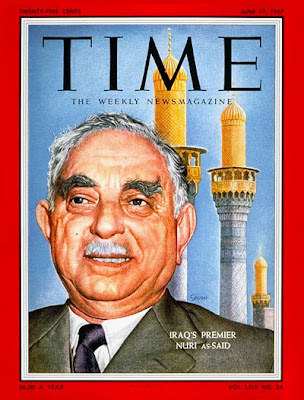 Fifty-two years ago, on July 14, 1958, the Free Officers movement in the Iraqi Army overthrew the government of King Faisal II (left), Crown Prince ‘Abd al-Ilah, and Prime Minister Nuri al-Sa‘id (below right, on the cover of Time). All three men died in the aftermath, Nuri being dragged through the streets.
Fifty-two years ago, on July 14, 1958, the Free Officers movement in the Iraqi Army overthrew the government of King Faisal II (left), Crown Prince ‘Abd al-Ilah, and Prime Minister Nuri al-Sa‘id (below right, on the cover of Time). All three men died in the aftermath, Nuri being dragged through the streets.The Hashemite monarchy in Iraq lasted only 37 years, 1921-1958, and three Kings (Faisal I, Ghazi, Faisal II). At the time of the overthrow, many Iraqis saw the monarchy as a creature of the British, though both the Kings and Nuri himself had their differences with Britain in their day.
The fact that Faisal, a prince of the Hijaz who at one point sought to rule Syria, was essentially imposed on Iraq by Gertrude Bell and the British, accounts in part for the relatively thin popularity of the monarchy in
Iraq. (By cotnrast, the Hashemites of Jordan, also derived from Hijaz, forged important alliances with important bedouin tribes and built up a power base.)
 A few years ago, Adeed Dawisha wrote a piece for MEJ (“Democratic Attitudes and Practices in Iraq, 1921-1952,” Middle East Journal, Winter 2005), in which he argued that the monarchical period in Iraq actually was more democratic than often given credit; this at a time when the conventional wisdom was that Iraq had never experienced any democracy. Certainly the Parliamentary period in Iraq between the wars, like the similar period in Egypt and Syria (what Albert Hourani called "the liberal age" in the Arab world) had many of the trappings of Parliamentarianism: multiple parties, elections, an independent press. It was, to be sure, imperfect. And certainly the monarchy was external, derived from abroad, imposed by the British, Sunni and Arab dominated in a country with large Shi‘ite and Kurdish populations.
A few years ago, Adeed Dawisha wrote a piece for MEJ (“Democratic Attitudes and Practices in Iraq, 1921-1952,” Middle East Journal, Winter 2005), in which he argued that the monarchical period in Iraq actually was more democratic than often given credit; this at a time when the conventional wisdom was that Iraq had never experienced any democracy. Certainly the Parliamentary period in Iraq between the wars, like the similar period in Egypt and Syria (what Albert Hourani called "the liberal age" in the Arab world) had many of the trappings of Parliamentarianism: multiple parties, elections, an independent press. It was, to be sure, imperfect. And certainly the monarchy was external, derived from abroad, imposed by the British, Sunni and Arab dominated in a country with large Shi‘ite and Kurdish populations.Oddly, there is an odd footnote here. Beginning in the 1990s, there was a flurry of discussion among some of the think tanks in this town — especially some of those that we would class as neoconservative — about a restoration of the Hashemites to replace Saddam Hussein. I felt, and most of the Iraq experts I knew felt, that this was purely moonbeams, since in a majority-Shi‘ite country with a large Kurdish population the idea of restoring a monarchy that had thin roots to begin with made little sense. I met one of the Hashemite claimants at one point, a man who seemed to know London better than Iraq, and I think the Jordanian Hashemites, especially former Crown Prince Hassan, may have been cheering the idea on. Predictably, of course, once Saddam was gone, there was no groundswell of enthusiasm for restoring the Hashemites.
Still and all, for all the weaknesses and unrepresentativeness of the monarchy, given the bloodshed that began that July of 1958 and continued in coup after coup, culminating in Saddam and what followed him, the passing of the monarchy, while no doubt inevitable, was not an unqualified progressive step.





1 comment:
In the years before the US invasion of Iraq in 2003, several members of the Hashemite family flirted with the idea of a restoration. Indeed, the late King Hussein showed some fleeting interest in the installation of one of his cousins from the Iraqi Hashemites, but in the end did almost nothing about it. In fact, he was quite cool to the more open interest of his brother Hassan, after passing over the latter for the Jordanian throne. The most active of the Iraqi Hashemites was Sharif Ali bin Al Hussein, whom many Americans met in London, as well as Washington. Sharif Ali was a very civilized Anglo-Arab gentleman, and some senior British officials promoted his case as early as 1991. He did not, however, enjoy the support of King Hussein and other members of the Jordanian branch. Moreover, in the end he proved to lack the base inside Iraq that he claimed would be there. The January 1990 elections had some negative political results and did not settle much, but they did make clear that Sharif Ali did not have significant popular support.
Post a Comment